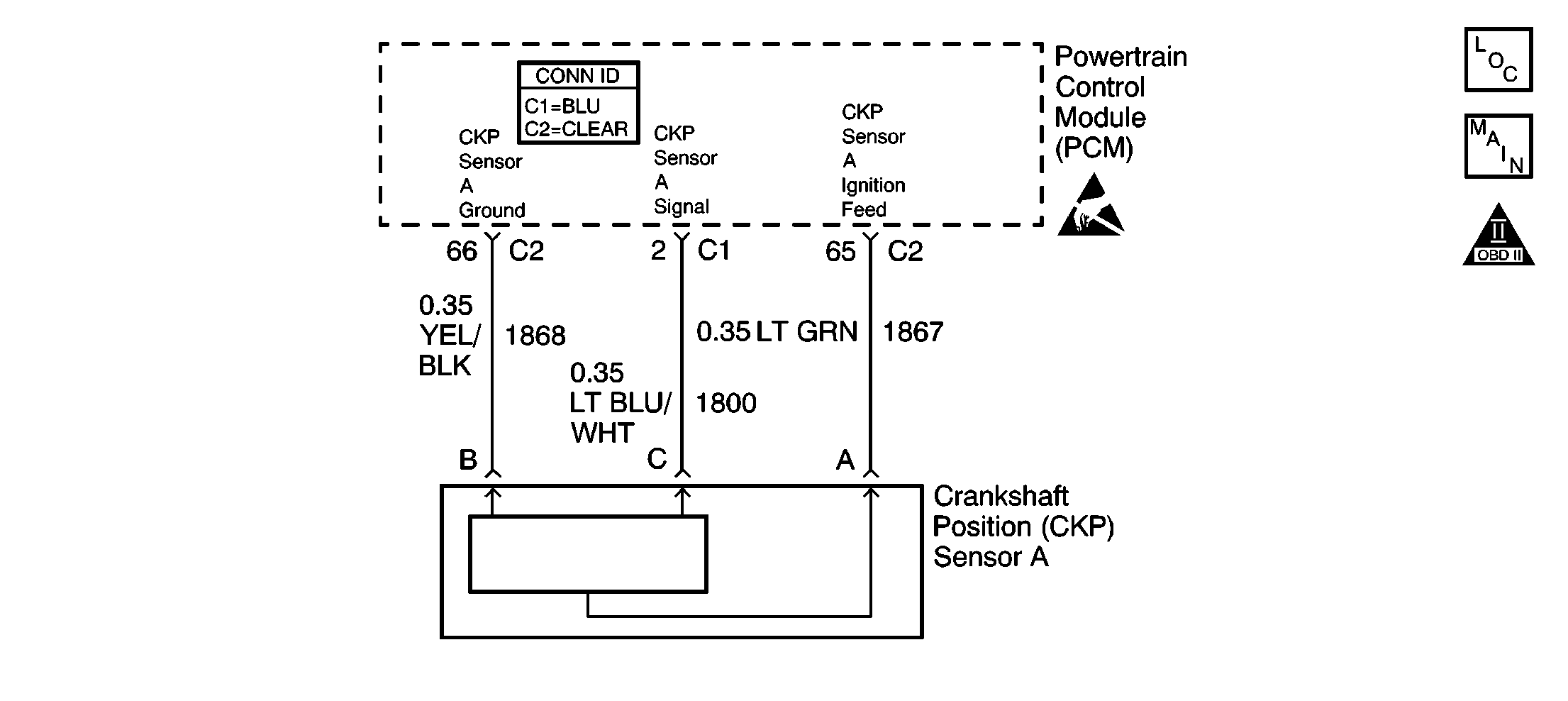
Circuit Description
The PCM uses dual crankshaft position (CKP A and CKP B) sensors to determine crankshaft position. The PCM supplies an ignition voltage and a ground for each sensor. During engine rotation, a slotted ring, machined into the crankshaft, causes the sensors to return a series of ON and OFF pulses to the PCM. The PCM uses these pulses to decode the position of the engine crankshaft.
The PCM uses two basic methods of decoding the engine position: Angle Based and Time Based (using either CKP A or CKP B sensor input). During normal operation, the PCM uses the angle based method. In order to operate in this mode, the PCM must receive signal pulses from both CKP sensors. The PCM uses the signal pulses to determine an initial crankshaft position, and to generate MEDRES (24X reference) and LORES (4X reference) signals. Once the initial crank position is determined, the PCM continuously monitors both sensors for valid signal inputs. As long as both signal inputs remain, the PCM will continue to use the angle based mode.
When either CKP signal is lost, the PCM will compare the MEDRES signal to the camshaft position (CMP) sensor signal. If the PCM detects a valid CMP signal, and the MEDRES to CMP signal correlation is correct, the PCM determines that CKP sensor A is at fault. However, if the MEDRES to CMP correlation is incorrect, the PCM determines that CKP sensor B is at fault. If the PCM determines that CKP sensor B is at fault, DTC P0385 will set. The PCM will switch from angle based mode to Time Based mode A using CKP sensor A signal input. If, after switching to Time Base A mode, the PCM detects an intermittent loss of CKP sensor A signal, DTC P0336 will set.
Conditions for Running the DTC
| • | The engine is cranking or running. |
| • | DTC P0385 has set. |
Conditions for Setting the DTC
The PCM detects an intermittent loss of CKP sensor A signal.
Action Taken When the DTC Sets
| • | The PCM illuminates the malfunction indicator lamp (MIL) during the second consecutive trip in which the diagnostic test runs and fails. |
| • | The PCM stores the conditions present when the DTC set as Freeze Frame/Failure Records data. |
Conditions for Clearing the MIL/DTC
| • | The PCM will turn the MIL OFF after the third consecutive trip in which the diagnostic runs and passes. |
| • | The history DTC will clear after 40 consecutive warm-up cycles have occurred without a malfunction. |
| • | The DTC can be cleared by using the scan tool Clear DTC Information function. |
Diagnostic Aids
If the condition is intermittent, refer to Intermittent Conditions .
Procedures for Selecting Crank Position Sensing Decode Mode
When diagnosing the crankshaft position sensors, it may be necessary to enable a specific decode mode (Angle, Time A, or Time B). To enable a specific crank decode, using the scan tool, perform the following steps:
| • | Turn the ignition to the RUN/ON position. |
| • | Select Engine Output Controls. |
| • | Select Crank Position Sensing Decode Mode. |
| • | Select the desired mode (Angle, Time A, or Time B) and press SELECT STATE. |
| • | Command the decode mode by pressing COMMAND STATE. |
The commanded state remains valid for the current ignition cycle. A specific decode mode can not be commanded with the engine running, or after commanding a desired decode mode. To command a different decode mode, you must cycle the ignition OFF and ON.
Test Description
The numbers below refer to the step numbers on the diagnostic table.
-
During normal operation, the PCM uses the Angle Mode to determine engine position. In order to operate in this mode, the PCM must receive valid input from both CKP sensors. If the PCM detects a loss of CKP sensor A signal, the PCM switches to a Time B mode using CKP sensor B input to determine engine position. If the PCM detects a loss of CKP sensor B, the PCM switches to a Time A mode using CKP sensor A input to determine engine position. If the PCM detects a loss of CKP sensor B signal, DTC P0385 will set. DTC P0336 will only set if a problem with CKP sensor A occurs while in Time A mode. DTC P0385 must be diagnosed first.
-
To properly verify any repair to CKP sensor A harnesses/connectors, the system must be commanded to operate in Time A mode. This forces the PCM to use CKP sensor A to determine engine position. If the system is functioning normally, DTC P0336 should not reset.
Step | Action | Values | Yes | No | ||||||||
|---|---|---|---|---|---|---|---|---|---|---|---|---|
1 | Did you perform the Powertrain On Board Diagnostic (OBD) System Check? | -- | ||||||||||
|
Important: If DTC P0385 is set, diagnose DTC P0385 before continuing with this table.
Did you find and correct the condition? | -- | |||||||||||
3 |
Did you find and correct the condition? | -- | ||||||||||
4 |
Did you find and correct the condition? | -- | ||||||||||
5 |
Did you find and correct the condition? | -- | Go to Diagnostic Aids | |||||||||
Does the scan tool indicate that DTC P0336 passed? | -- | System OK |
